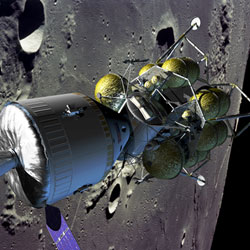
Stardust’s sample return capsule, safely back on Earth. Image credit: NASA/JPL. Click to enlarge.
NASA’s Stardust spacecraft is now back home, having traveled 4.6 billion kilometers (3 billion miles) and successfully completed its mission in space. On January 15, Stardust’s Sample Return Capsule (SRC) landed safely in the Utah desert, containing samples of a comet’s coma and interstellar dust particles. Stardust was launched in 1999, and in January 2004, the spacecraft performed a risky and historic flyby of Comet Wild 2 to capture the samples and take pictures of the comet’s nucleus.
The trickiest part of the mission, however, may have been guiding the spacecraft back home. The Stardust Navigation Team at NASA’s Jet Propulsion Laboratory in California has been working around the clock for the past few weeks, preparing to bring Stardust’s SRC back through Earth’s atmosphere to land in the US Air Force’s Utah Test and Training Range, southwest of Salt Lake City.
For a successful re-entry and landing, the Navigation team had to target the capsule’s entry to a specific point in the Earth’s atmosphere to within eight 100ths of a degree. One mission manager compared that feat to hitting the eye of a sewing needle from across the room.
Throughout the mission the Stardust scientists have heralded the performance of this desk-sized spacecraft. But members of the Navigation Team have maintained that Stardust’s design provided unprecedented navigation challenges during its entire 7- year mission, culminating with the Earth return.
“Navigating this spacecraft has always been extremely difficult because the attitude control thrusters are all mounted on the same side of the spacecraft,” said Neil Mottinger, a member of the Navigation and Entry, Descent and Landing teams.
The thrusters provide gentle pushes that allow a spacecraft to maintain the correct position while in flight. Normally, most spacecraft have their thrusters placed equally around all sides, but Stardust’s thrusters were positioned so the plume of the thrusters wouldn’t contaminate the particle collector.
“This ‘unbalanced’ thruster design causes a velocity change every time the spacecraft needed to control its attitude, which can occur hundreds of times a day,” said Christopher Potts, the Technical Supervisor of the Flight Path Control Group. “Each thruster pulse is extremely small, but the large number adds up to a significant effect on the trajectory.”
Consequently, the Navigation team needed to closely monitor the daily activity of the spacecraft. “It’s a little like trying to catch a knuckleball,” said Potts, “as the spacecraft trajectory changed noticeably as it reacted to its local space environment.”
Mottinger said that in some aspects, the spacecraft was almost like a bucking bronco. “It was impossible to predict when the thrusters would fire during normal spacecraft operations,” he said, “let alone the times when it would go into a safe mode, firing the thrusters quite frequently to obtaining a ‘safe’ attitude, awaiting further instructions from Earth.”
Both Mottinger and Potts said that in the past few weeks, the Navigation team has gone through tests, training and several full rehearsals for the spacecraft’s return. “We spent a large amount of time postulating what could go wrong,” Potts said, “and making sure there was an appropriate response to correct the problem.”
But with the Navigation Team’s diligent guidance, the SRC landed perfectly, much to the delight and relief of everyone involved with Stardust. Stardust Project Manager Thomas Duxbury said at a press conference following the landing, “This thing went like clockwork. We released this capsule from our spacecraft and it hit the atmosphere exactly on time.”
Mottinger said the hard work the team put in was definitely worth the rewards. “This team has to be exhausted,” he said. “It’s been a real challenge to predict where the spacecraft was headed and fine-tune the entry. I’m in awe of everyone on the Navigation Team who made all this happen.”
Stardust’s SRC will be brought to a clean room at the Johnson Space Center in Houston to be opened. Scientists from around the world will be able to study the thousands of particles of cometary and interstellar dust, many smaller than the width of a human hair. The particles were collected from the coma or “tail,” a cloud of gas and dust that surrounds a comet.
Comets are intriguing bodies, formed in the outer regions of the solar system. Scientists consider comets to be the best samples available of the original building blocks of our solar system, and that the particles Stardust returned should be able to tell us about the conditions of the early solar system.
To determine the makeup of the collected particles, scientists will cut the samples into even smaller pieces and investigate them with powerful microscopes. Stardust scientists are recruiting volunteers to search for the interstellar dust particles using virtual microscopes.
The collector is about the size and shape of a tennis racquet, and is made of a unique substance called Aerogel. Aerogel is made of silicon, but is 99.8% air, so it is the least dense man-made substance. It feels like an extremely light, very fine, dry sponge, and it has the ability to capture fast moving dust. It’s very strong, and easily survived the capsule’s landing on solid ground.
Mottinger and Potts both look forward to seeing the results that the study of Stardust’s samples will bring.
“The entire Navigation team realized we were responsible for delivering a ‘priceless’ cargo of pristine cometary material samples from a comet’s coma,” said Potts. “These samples represent a glimpse back in time at the early formation of the solar system. There’s little doubt that new science discoveries will be made which will influence the direction of future space exploration.”
Written by Nancy Atkinson






